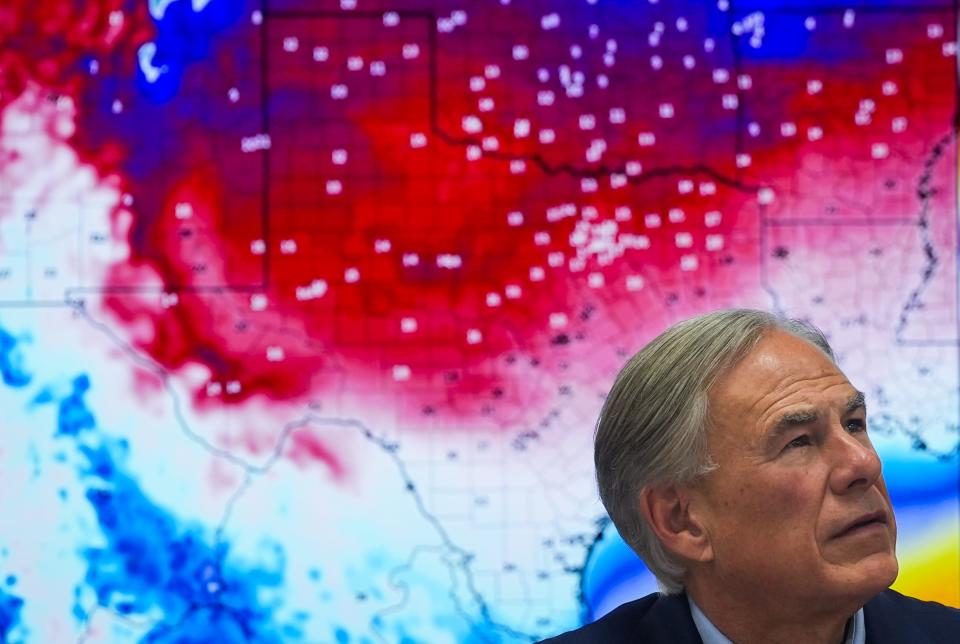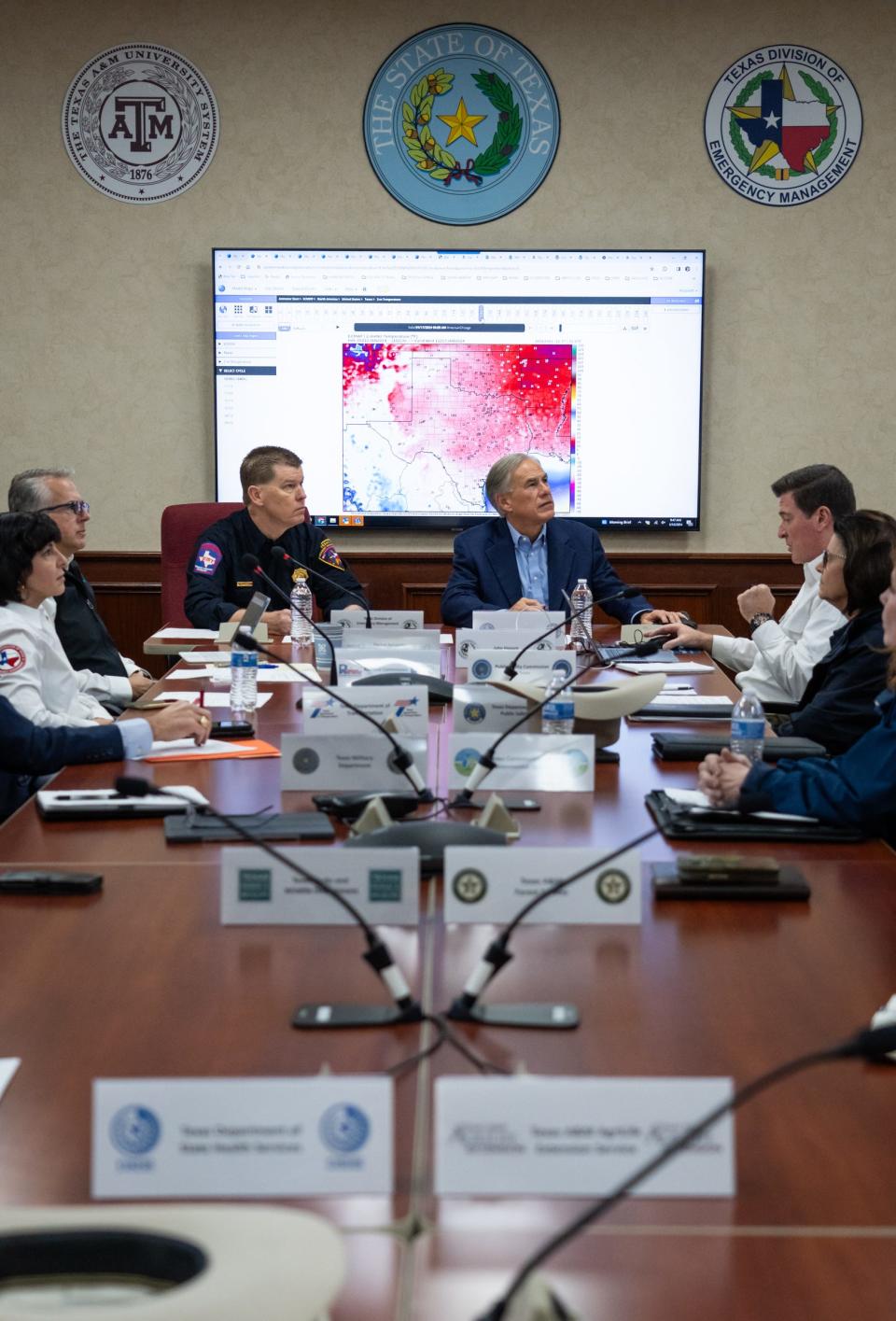Texas is preparing for arctic blast. Here's how state is helping cities, counties respond
- Oops!Something went wrong.Please try again later.
The state is preparing for Texans to face some of the coldest temperatures Texans have seen in their lifetimes beginning Saturday, but the energy grid is expected to handle the expected high demand for power, Gov. Greg Abbott said in a news conference Friday.
"I know a lot of people are concerned, 'Is the power going to stay on?'" Abbott said. "We feel very good about the status of the Texas power grid and (the Electric Reliability Council of Texas) to be able to effectively and successfully ensure that the power is going to be able to stay on throughout the entirety of this episode."
The state's electric grid is likely to face the most strain from heating demands Tuesday and Wednesday mornings because the wind power supply is forecast to be lower, Abbott said. Wind power accounted for 29% of Texas energy generation in 2023.
More: These 3 maps forecast Texas winter conditions
From an underground bunker in North Austin that has served as the state's crisis response center since the 1950s, Abbott and several agency heads laid out the state's preparations — and urged individuals to prepare — for the incoming arctic blast that will keep northern parts of Texas under subfreezing temperatures for 80 to 90 consecutive hours.

The governor and Texas Division of Emergency Management Chief Nim Kidd were emphatic that the freeze could pose significant safety risks, with Abbott saying his goal was to "make it through this episode protecting the life of every Texan."
The cold front will bring temperatures well below average from Saturday night through Wednesday, officials said. So far, very little to no precipitation is forecast, but the chance of freezing rain is slightly higher in Central and East Texas. ERCOT, the state's electric grid operator, has issued a weather watch for Monday through Wednesday, though no energy conservation requests are expected, officials said Friday.
The governor and other state agency heads were eager to show Texans that the executive branch has learned from its mistakes since a winter storm caused millions to lose power for days due to electric grid failures and left more than 250 people dead in February 2021, nearly three years ago.
"What people should expect … is that this will be one of the coldest episodes they will have lived through in the state of Texas," Abbott said. "It will last for several days, but it will not be anything close to what we experienced during Winter Storm Uri (in 2021). And I want to emphasize that we are much, much more prepared for this than we were for Winter Storm Uri."

The state's electric grid has fared far better during winter storms that have occurred since the 2021 event, and experts say increased power generation and checkups by ERCOT have prepared the grid to handle the power demands expected during the upcoming arctic blast. But officials warned that local outages caused by downed trees and ice on power lines are still possible, and they said Texans should reach out to their local power companies for help in those cases.
How Texas is preparing for the arctic blast
The governor directed the Division of Emergency Management to increase its emergency preparations to Level II Readiness on Jan. 7, which signals that "the scope of an event has expanded beyond what can be handled by local responders," per the division's Executive Guide.
Two levels above everyday operations, Level II Readiness usually prompts increased staffing and extended hours at emergency facilities as well as coordination among state, county and local governments. The state had been at Level III as a result of conditions at the border.
More: ERCOT says the Texas electrical power grid is 'expected to handle' arctic blast
The Texas Railroad Commission, which manages the state's natural gas resources, said the supply is expected to be more than sufficient to last the duration of the freeze, but that compressed natural gas trucks are positioned throughout the state to provide additional fuel if needed.
"We have more (fuel) storage available and full than we ever have before," commission Chair Christi Craddick said at the news conference.
Local governments and other organizations, not the state, will open warming centers. The State Operations Center helps ensure they have sufficient centers and liaisons among the volunteer organizations that help staff them, Kidd said.
"There's no reason for people to stay cold inside their homes with all of the warming centers we have open across the state," Kidd said.

In addition, the Texas Department of Transportation is helping coordinate treatment of roads in areas that might receive precipitation.
The Texas Division of Emergency Management also helps respond to local governments' requests for additional resources. In Austin, for example, the city and Travis County jointly respond to emergencies. If they are lacking something, they reach out to neighboring counties, and if they still can't obtain it, they can submit a request to the state through an online portal.
"There's a really great relationship between the city, the county and the TDEM," Sarah Henry, a spokeswoman for the Austin Homeland Security and Emergency Management Office, told the American-Statesman.
How you can prepare
Abbott and agency heads emphasized Texans' personal responsibility to prepare and make safe choices.
"There will be ultra-cold temperatures, and we need to make sure that everybody in the state of Texas is aware of what's coming," he said. "We want to ensure every Texan is aware of what they can do for themselves."
That includes staying indoors amid dangerously cold temperatures and staying off the roads as driving conditions could become perilous due to possible freezing rain.
"Anybody who gets out on the road and drives in an area that is very cold, or that has any precipitation on it, needs to understand that is a very dangerous situation," Abbott said.
One risk that some Texans might be less familiar with is carbon monoxide poisoning, which "always" happens during winter weather events, Kidd said. As explained in a memo from the state Health and Human Services Department, generators and other heat sources like cars should never be operated indoors or in a garage.
You can read more about how to protect the four P's — people, pipes, plants and pets — on our website.
This article originally appeared on Austin American-Statesman: Texas arctic blast: How Gov. Greg Abbott, state is preparing

